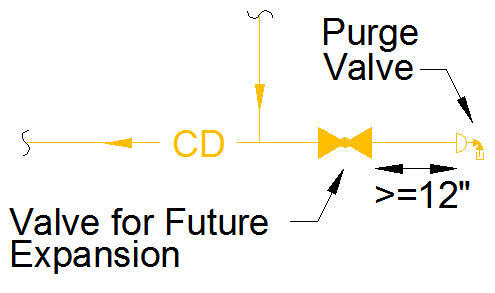It’s always a good idea to plan for additions to your refrigeration system when you install it or improve it. Loads always seem to increase as new production capacity or storage areas are brought on line.
Here’s an example of how to install a valve for future expansion purposes:
Although only a single condenser was installed at this facility they decided they would like to size the pipes properly for a second condenser on the same line. To make that future installation easier they installed a valve for future expansion followed by a length of pipe and a small purge valve.
The CD (Condenser Drain) line is coming from the single condenser (at the top of the drawing) and continues to the High Pressure Receiver (the left side of the drawing.) What we’re looking at here is what was done on the right side of the drawing: this is how they prepared for future expansion.
The “Valve for Future Expansion” will someday be the CD Isolation Valve for a new condenser. For now it’s normally closed. We can’t leave the valve just hanging there though so you need to install a blind flange or a welded cap. In this case they installed a 24” length of pipe with a welded cap and a purge valve. The Purge Valve is usually a gauge valve – its purpose is to provide a drain point in case you get seepage past the normally closed valve. The distance is important – when you decide to add that second condenser we want at least 12” of pipe between the valve and the welding so the heat from the welding doesn’t harm the valve seat. For further protection you could add a heat sink like wet rags wrapped around the pipe during welding.
If this valve arrangement was done on the HSD (High Side Discharge) and EQ (Equalizing) lines as well, you could add your second condenser without having to pump down those lines and avoid a system shutdown.
IIAR Bulletin 107 has some other examples and other advice.


